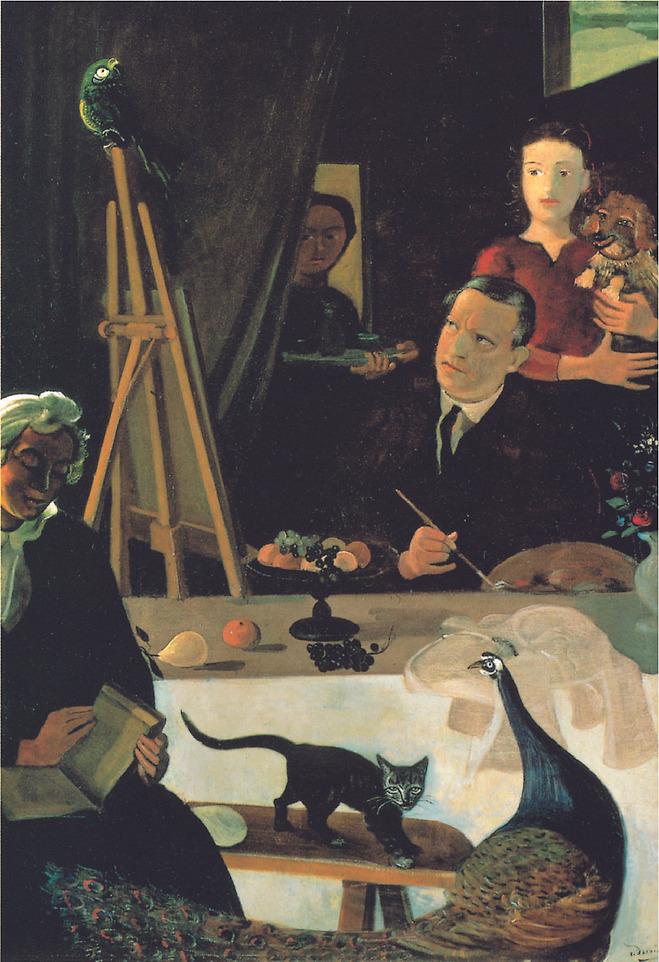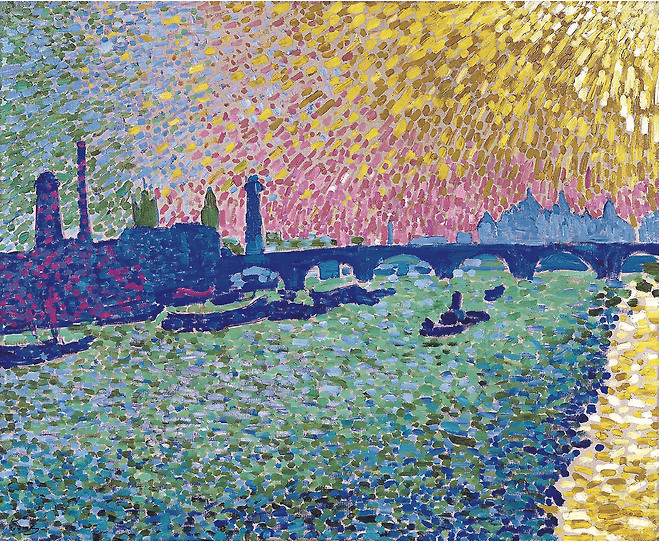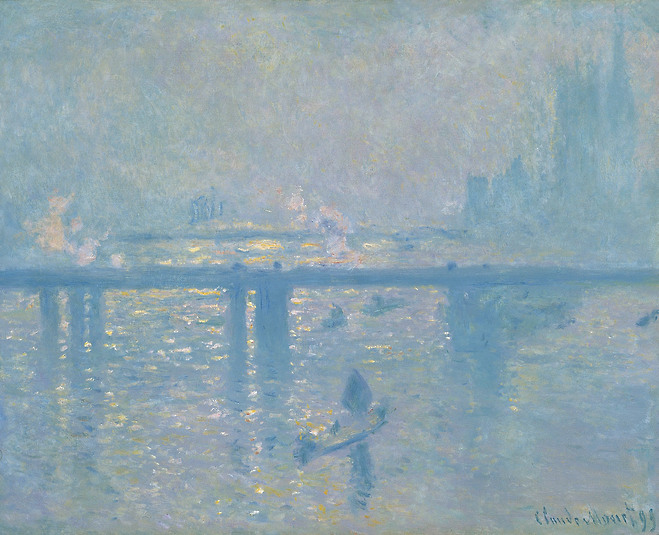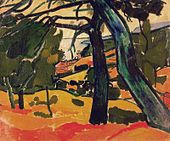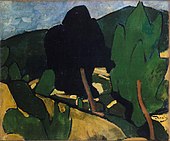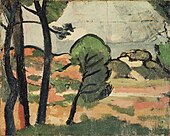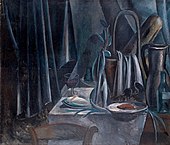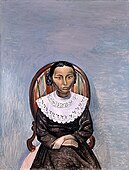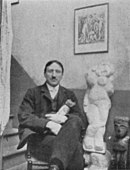앙드레 드랭[André Derain]
(1880-1954)
야수파에서 중요한 위치를 차지하는 프랑스의 화가.
파리의 카리에르 미술학교와 쥘리앙 미술학교에서 그림을 배웠고 1900년에 만난 모리스 드 블라맹크 및 1905년에 알게 된 앙리 마티스와 함께 자신의 초기 화풍을 개발했으며, 이 2명의 화가들과 더불어 1905~08년에 야수파를 대표하는 주요 화가가 되었다. 그는 화려한 원색으로 풍경화와 인물 스케치를 그렸고, 자발적인 구성의 특징을 나타내기 위해 단절된 붓놀림과 충동적인 선을 이용했다. 잠시 폴 세잔의 작품에 영향을 받았던 1908년에 야수파와 손을 끊었고 몇 년 동안 판에 박힌 입체파 양식으로 그림을 그렸지만, 1920년대에 이르자 그의 누드화·정물화·초상화는 신고전주의 쪽으로 점점 기울어졌고, 자발적이고 충동적인 초기 작품의 특징은 차츰 사라졌다.1920년대 이후 그의 화풍은 사실상 전혀 변화하지 않았다. 드랭은 실내 장식가로서 상당한 능력을 갖고 있었으며 극장의 무대장식을 많이 제작했는데. 특히 러시아 발레단을 위해 제작한 무대장식이 유명하다. 또한 책의 삽화도 많이 그렸다. [다음백과]
〈워털루 다리〉 El puente de Waterloo
티센 미술관에서 대략 시대순으로 작품을 감상하면서 내려오다 보면, 어느 순간 갑자기 눈앞에서 근사한 폭죽이 터지는 순간이 온다. 바로 앙드레 드랭(André Derain, 1880-1954)의 〈워털루 다리〉 앞에서다. 르네상스 작품들의 우아함과 정교함도 좋고 바로크 시대의 강렬한 빛과 어둠도 좋지만, 이런 화려한 색채 앞에서는 누구나 넋을 잃는다.
앙드레 드랭은 프랑스 출신 화가로, 1905년 콜리우르(Collioure)라는 휴양지에서 마티스와 함께 머물며 점묘법을 받아들여 그곳의 풍광을 그렸다. 점묘법은 조르주 쇠라(Georges Pierre Seurat)와 폴 시냑(Paul Signac)이라는 화가가 시작한 기법인데, 무수히 작은 점들을 찍어 그림을 그리기 때문에 점묘법이라고 부른다. 두 가지 이상의 물감을 섞어서 원하는 색을 만들어 내는 기존의 방식으로는 채도가 떨어지기 때문에, 원색들을 섞지 않고 점을 찍어 색을 표현했다. 빨강과 노랑을 나란히 배치하여 멀리서 보면 주황색으로 보인다거나 자잘한 흰색과 검은색 바둑판무늬 옷을 멀리서 보면 회색으로 보이는 이치다. 드랭과 마티스는 바다와 항구가 있는 여름 휴양지 콜리우르의 밝은 색감을 강렬한 원색의 점묘법으로 그렸다.
한편 마티스와 드랭을 비롯한 젊은 작가들이 같은 해의 《살롱 도톤(Salon d’Automne)》 전시에서 강렬한 색이 주조가 되는 작품을 내놓았다. 그들의 작품들 가운데 고전적인 조각 작품이 있는 것을 보고 한 비평가가 ‘야수들 사이에 도나텔로(Donatello, 르네상스 시대의 조각가)가 서 있군!’ 하고 비판적으로 이야기한 것에서 이들을 야수주의라고 부르기 시작했다. 사실, 대부분 미술사조의 명칭은 부정적인 내용에서 시작된 것이 많다. 그만큼 무엇인가 새로운 것은 기존의 스타일에 익숙한 이들에게는 거부의 대상이며 어색한 것이다.
야수라고 불리기 시작한 이 젊은 화가들이 추구했던 것은 인상주의자들처럼 눈에 보이는 대로 시시각각 변하는 풍경의 모습을 그리는 것이 아니라 회화의 필수 요소인 색의 표현력을 극대화하여 눈에 보이는 것 너머의 본질을 그리고자 하는 것이었다. 회화에서 색은 정해진 무엇인가를 의미하던 시절도 있었다. 그리스도교 미술에서 황금색은 신의 색이었다. 붉은색은 예수의 수난을 의미했고, 짙은 푸른색은 고귀한 성모 마리아의 상징이었다. 그러다 화가들은 이런 종교적인 의미들을 떨쳐버리고 눈에 보이는 대로 사물을 그렸다. 인상주의자들은 시시각각 변하는 빛에 따라 한 물건이 다른 빛을 띠도록 그렸다.
야수주의에 이르러 색은 종교적인 의미도 아니고, 보이는 대로 칠해야만 하는 것도 아니었다. 색이 회화의 주인공이 된 것이다. 그래서 이들의 그림을 보면 얼굴의 반은 초록색이고 나머지 반은 붉은색인 여인도 있고, 사물의 그림자는 더 이상 회색이나 연보라색이 아니다.
우리가 보는 이 워털루 다리도 그렇다. 앙드레 드랭은 볼라르(Ambroise Vollard)라는 미술상의 작업 요청을 받고 런던으로 가서 그곳의 풍경을 30점 그렸는데, 이 작품은 그중의 하나다. 그는 터너, 모네가 그렸던 런던의 다리와는 완전히 다른 유화를 완성했다. 점묘법으로 그린 푸른색 다리와 공장들, 국회의사당, 밝은 푸른색 강물, 노란색 점으로 표시된 강가, 그리고 무엇보다도 막 폭발한 것 같은 노란색, 연자주색 하늘이 우리의 시선을 사로잡는다. 야수주의에게 색이란 ‘빛을 터뜨리는 것이 임무인 다이너마이트 폭탄’이었으니까.
===========================================================================================================
André Derain (French: [dəʁɛ̃]; 10 June 1880 – 8 September 1954)
was a French artist, painter, sculptor and co-founder of Fauvism with Henri Matisse
Biography
Early years
Derain was born in 1880 in Chatou, Yvelines, Île-de-France, just outside Paris. In 1895 Derain began to study on his own, contrary to claims that meeting Vlaminck or Matisse began his efforts to paint, and occasionally went to the countryside with an old friend of Cézanne's, Father Jacomin along with his two sons.[2] In 1898, while studying to be an engineer at the Académie Camillo,[3] he attended painting classes under Eugène Carrière, and there met Matisse. In 1900, he met and shared a studio with Maurice de Vlaminck and together they began to paint scenes in the neighbourhood, but this was interrupted by military service at Commercy from September 1901 to 1904.[4] Following his release from service, Matisse persuaded Derain's parents to allow him to abandon his engineering career and devote himself solely to painting; subsequently Derain attended the Académie Julian.[5]
Fauvism[edit]
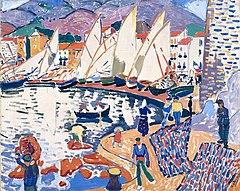
Derain and Matisse worked together through the summer of 1905 in the Mediterranean village of Collioure and later that year displayed their highly innovative paintings at the Salon d'Automne. The vivid, unnatural colors led the critic Louis Vauxcelles to derisively dub their works as les Fauves, or "the wild beasts", marking the start of the Fauvist movement. In March 1906, the noted art dealer Ambroise Vollard sent Derain to London to produce a series of paintings with the city as subject. In 30 paintings (29 of which are still extant), Derain presented a portrait of London that was radically different from anything done by previous painters of the city such as Whistler or Monet. With bold colors and compositions, Derain painted multiple pictures of the Thames and Tower Bridge. These London paintings remain among his most popular work. Art critic T.G Rosenthal: "Not since Monet has anyone made London seem so fresh and yet remain quintessentially English. Some of his views of the Thames use the Pointillist technique of multiple dots, although by this time, because the dots have become much larger, it is rather more simply the separation of colours called Divisionism and it is peculiarly effective in conveying the fragmentation of colour in moving water in sunlight."[6]

In 1907 art dealer Daniel-Henry Kahnweiler purchased Derain's entire studio, granting Derain financial stability. He experimented with stone sculpture and moved to Montmartre to be near his friend Pablo Picasso and other noted artists. Fernande Olivier, Picasso's mistress at the time, described Derain[7] as:
Slim, elegant, with a lively colour and enamelled black hair. With an English chic, somewhat striking. Fancy waistcoats, ties in crude colours, red and green. Always a pipe in his mouth, phlegmatic, mocking, cold, an arguer.
At Montmartre, Derain began to shift from the brilliant Fauvist palette to more muted tones, showing the influence of Cubism and Paul Cézanne.[8] (According to Gertrude Stein, there is a tradition that Derain discovered and was influenced by African sculpture before the Cubists did.[9]) Derain supplied woodcuts in primitivist style for an edition of Guillaume Apollinaire's first book of prose, L'enchanteur pourrissant (1909). He displayed works at the Neue Künstlervereinigung in Munich in 1910,[10] in 1912 at the secessionist Der Blaue Reiter[11] and in 1913 at the seminal Armory Show in New York. He also illustrated a collection of poems by Max Jacob in 1912.
Towards a new classicism
At about this time Derain's work began overtly reflecting his study of the Old Masters. The role of color was reduced and forms became austere; the years 1911–1914 are sometimes referred to as his gothic period. In 1914 he was mobilized for military service in World War I and until his release in 1919 he would have little time for painting, although in 1916 he provided a set of illustrations for André Breton's first book, Mont de Piete.
After the war, Derain won new acclaim as a leader of the renewed classicism then ascendant. With the wildness of his Fauve years far behind, he was admired as an upholder of tradition.[12] In 1919 he designed the ballet La Boutique fantasque for Diaghilev, leader of the Ballets Russes.[13] A major success, it would lead to his creating many ballet designs.
The 1920s marked the height of his success, as he was awarded the Carnegie Prize in 1928 for his "Still-life with Dead Game" and began to exhibit extensively abroad—in London, Berlin, Frankfurt, Düsseldorf, New York City and Cincinnati, Ohio.[7]
During the German occupation of France in World War II, Derain lived primarily in Paris and was much courted by the Germans because he represented the prestige of French culture. Derain accepted an invitation to make an official visit to Germany in 1941, and traveled with other French artists to Berlin to attend a Nazi exhibition of an officially endorsed artist, Arno Breker.[8] Derain's presence in Germany was used effectively by Nazi propaganda, and after the Liberation he was branded a collaborator and ostracized by many former supporters.[14]
A year before his death, he contracted an eye infection from which he never fully recovered. He died in Garches, Hauts-de-Seine, Île-de-France, France in 1954 when he was struck by a moving vehicle.[15]
Derain's London paintings were the subject of a major exhibition at the Courtauld Institute from 27 October 2005 to 22 January 2006.[16]
Works[edit]
Self-portrait in studio, c.1903, oil on canvas, 42.2 x 34.6 cm, National Gallery of Australia
Pinède à Cassis (Landscape), 1907, oil on canvas, 54 x 65 cm, Musée Cantini, Marseille
André Derain, 1907, Paysage à Cassis, oil on canvas, 54 x 64 cm, Musée d'art moderne de Troyes
Landscape in Provence (Paysage de Provence), c.1908, oil on canvas, 32.2 x 40.6 cm, Brooklyn Museum, Brooklyn
View of Cagnes, 1910, oil on canvas, Museum Folkwang, Essen, Germany
La Table (The Table), 1911, oil on canvas, 96.5 x 131.1 cm, Metropolitan Museum of Art, New York
The Last Supper, 1911, oil on canvas, 227.3 x 288.3 cm, Art Institute of Chicago
Window on the Park (La Fenêtre sur le parc), 1912, oil on canvas, 130.8 x 89.5 cm, Museum of Modern Art
Nature morte (Still Life), 1912, oil on canvas, 100.5 x 118 cm, The State Hermitage Museum, Saint Petersburg, Russia. Reproduced in Du "Cubisme", 1912
Le Samedi, 1913–14, oil on canvas, 181 x 228 cm, Pushkin Museum, Moscow
Portrait of a Girl in Black, 1913, Hermitage Museum
'♣ 미술(美術) 마당 ♣ > - 작품[作品]' 카테고리의 다른 글
| 파블로 피카소 - 〈기다림(마고)〉L’espera(Margot) (0) | 2019.06.03 |
|---|---|
| 파블로 피카소 - 시녀들[Las Meninas ] (0) | 2019.06.02 |
| George Romney - Emma, Lady Hamilton (0) | 2019.04.30 |
| 세상에서 가장 비싼 그림:1위부터 100위까지! (2014년 기준) (0) | 2019.02.23 |
| [스크랩] 키스, 그 달콤한 유혹 / 작가 박희숙의 Art 에로티시즘 19 (0) | 2018.05.31 |

